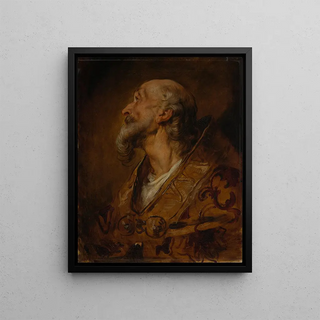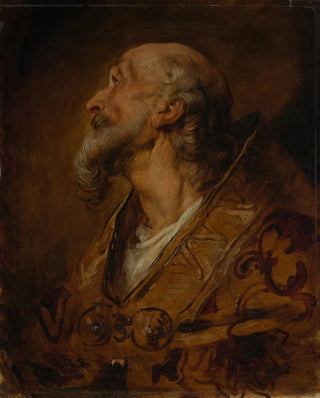Art print | Portrait en busto d'un vescovo - Hans Canon


View from behind

Frame (optional)
Portrait art print of a bishop bust - Hans Canon – Captivating introduction
In the fascinating universe of Renaissance painting, some works stand out for their depth and ability to capture the human essence. Among these, the "Portrait bust of a bishop" by Hans Canon presents itself as an emblematic example of the artistic mastery of its time. This painting, which evokes both spirituality and dignity, invites us to delve into the intimacy of its subject, revealing a rare emotional complexity. Through this work, Canon succeeds in transcending the simple portrait to create a true testament of his era, a window into the values and beliefs of a rapidly changing world.
Style and uniqueness of the work
The "Portrait bust of a bishop" is characterized by formal rigor and meticulous attention to detail. The composition, centered on the bishop's face, immediately draws the eye, while the dark background highlights the subtle nuances of the ecclesiastical robe's colors. The artist skillfully plays with light, creating delicate shadows that accentuate facial features and bring the subject's expression to life. The eyes, with an almost living sparkle, seem to follow the viewer, establishing a powerful emotional connection. This art print does not merely depict a man in a position of authority; it evokes a complex personality, full of stories and responsibilities. The richness of textures, from clothing to accessories, testifies to Canon's exceptional craftsmanship and his desire to capture not only the appearance but also the soul of his subject.
The artist and his influence
Hans Canon, a 16th-century Flemish painter, managed to establish himself in the artistic landscape of his time thanks to his undeniable talent and his ability to incorporate influences from Italian Renaissance while remaining true to his Nordic roots. Trained in a context where portraiture took a prominent place, he developed a style that combines realism and idealization. His works are marked by a particular attention to the psychology of the characters, a feature that sets him apart from his contemporaries. Canon was also a pioneer in the use of color and light, inspiring many artists who followed him.

Matte finish

View from behind

Frame (optional)
Portrait art print of a bishop bust - Hans Canon – Captivating introduction
In the fascinating universe of Renaissance painting, some works stand out for their depth and ability to capture the human essence. Among these, the "Portrait bust of a bishop" by Hans Canon presents itself as an emblematic example of the artistic mastery of its time. This painting, which evokes both spirituality and dignity, invites us to delve into the intimacy of its subject, revealing a rare emotional complexity. Through this work, Canon succeeds in transcending the simple portrait to create a true testament of his era, a window into the values and beliefs of a rapidly changing world.
Style and uniqueness of the work
The "Portrait bust of a bishop" is characterized by formal rigor and meticulous attention to detail. The composition, centered on the bishop's face, immediately draws the eye, while the dark background highlights the subtle nuances of the ecclesiastical robe's colors. The artist skillfully plays with light, creating delicate shadows that accentuate facial features and bring the subject's expression to life. The eyes, with an almost living sparkle, seem to follow the viewer, establishing a powerful emotional connection. This art print does not merely depict a man in a position of authority; it evokes a complex personality, full of stories and responsibilities. The richness of textures, from clothing to accessories, testifies to Canon's exceptional craftsmanship and his desire to capture not only the appearance but also the soul of his subject.
The artist and his influence
Hans Canon, a 16th-century Flemish painter, managed to establish himself in the artistic landscape of his time thanks to his undeniable talent and his ability to incorporate influences from Italian Renaissance while remaining true to his Nordic roots. Trained in a context where portraiture took a prominent place, he developed a style that combines realism and idealization. His works are marked by a particular attention to the psychology of the characters, a feature that sets him apart from his contemporaries. Canon was also a pioneer in the use of color and light, inspiring many artists who followed him.






